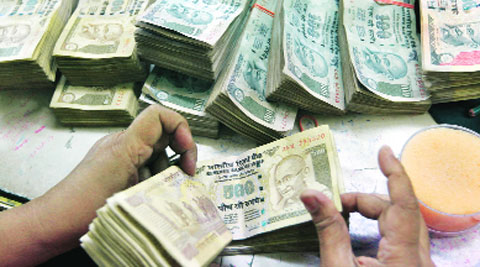By எஸ். ராமன்
Dinamani 07 March 2014 01:02 AM IST
அரசுடைமையாக்கப்பட்ட வங்கிகளில் வளர்ந்து வரும் வாராக்கடன்கள், நிதி அமைச்சகத்தையும், ரிசர்வ் வங்கியையும் திகைக்க வைத்திருக்கின்றன. இதன் எதிரொலியாக, கடந்த ஜனவரி 30ஆம் தேதியன்று, வாராக்கடன்களை தவிர்ப்பதற்கான முன்னெச்சரிக்கை நடவடிக்கைகள், அவற்றிற்கு புத்துயிர் ஊட்டுதல் மற்றும் கடன் வசூலுக்கு தேவையான வங்கிகளின் ஒருங்கிணைந்த செயல்பாடுகள் ஆகியவற்றைப் பற்றிய புதிய திட்டங்கள் அடங்கிய அறிக்கையை (Framework for revitalising distressed assets) இந்திய ரிசர்வ் வங்கி வெளியிட்டுள்ளது.
பெருந்தொகை கடன்கள் வழங்குவதற்கான ஆய்வு முறையை வங்கிகள் வலுப்படுத்த வேண்டும். வழங்கப்பட்ட கடன்களின் பயன்பாடுகளை (End use of funds) கண்காணிக்கும் முறையை மேம்படுத்த வேண்டும். கடனாளிகளைப் பற்றிய தகவல் பரிமாற்றம், வங்கிகளுக்கிடையே கட்டாயம் தேவை. ரிசர்வ் வங்கி, கடனாளிகளின் செயல்பாடுகள் பற்றிய விவரங்களை வங்கிகளுடன் பகிர்ந்து கொள்வதற்கான முயற்சிகளை மேற்கொள்ளும்.
ஒரு கடன் கணக்கில், நலிவுத் தன்மை வெளிப்பட ஆரம்பித்த உடனேயே, கடன் வழங்கிய வங்கிகள் ஒருங்கிணைந்து, கடனை வசூலிக்க தேவையான நடவடிக்கைகளில் ஈடுபடவேண்டும் போன்ற சிபாரிசுகள் இந்த அறிக்கையில் அடங்கியிருக்கின்றன.
கடந்த டிசம்பர் மாத நிலவரப்படி, வங்கிகளின் வாராக்கடன் 2 லட்சம் கோடி ரூபாயை தாண்டியிருப்பதுதான் ரிசர்வ் வங்கியின் புதிய திட்டங்களுக்கான காரணம். இதில் பெரும்பகுதி அரசுடைமையாக்கப்பட்ட வங்கிகளின் வாராக்கடன்களாகும். கடந்த காலத்தை விட, இது சுமார் 35 சதவீதம் அதிகரித்துள்ளது. இதைத் தவிர, மறுசீரமைப்புக்கு (Rescheduling) உட்படுத்தப்பட்ட கடன் தொகை ரூ.4 லட்சம் கோடியாக அதிகரித்து நிற்கிறது.
மறுசீரமைப்புக்கு உட்படுத்தப்பட்ட கடன்களின் பெரும்பகுதி, வாராக்கடன் என்ற புதைகுழியின் நுழைவாயிலில் காத்திருப்பவையாகும். நிலக்கரி, ஜவுளி மற்றும் சணல் பொருள் உற்பத்தி, மென்பொருள், தோல் பொருள்கள் உற்பத்தி, சர்க்கரை, புகையிலை, ரப்பர், உலோகங்கள், கட்டுமானம், சமையல் எண்ணெய் போன்ற துறைகளுக்கு வழங்கப்பட்ட கடன்கள், பெருமளவில் வாராக்கடன்களாக மாறி, 51 சதவீத இடத்தை ஆக்கிரமித்திருக்கின்றன.
ரிசர்வ் வங்கியின் மற்றொரு ஆய்வு அறிக்கை (Working paper on Re-emerging stress in the asset quality of Indian banks), வரும் காலங்களில் வாரக்கடன்கள் மேலும் அதிகரிக்க வாய்ப்பிருப்பதாக எச்சரிக்கை செய்கிறது.
இந்த அளவீடு கடந்த காலத்தைவிட 100 சதவீதம் அதிகமானால், அது வங்கிகளின் தற்போதைய மூலதனத்தில் 40 சதவீதத்தை "கபளீகரம்' செய்து விடும் அபாயம் இருப்பதாக ரிசர்வ் வங்கியின் நிதி நிறுவனங்களின் ஸ்திரத்தன்மை (ஊண்ய்ஹய்ஸ்ரீண்ஹப் ள்ற்ஹக்ஷண்ப்ண்ற்ஹ் ழ்ங்ல்ர்ழ்ற்) பற்றிய அறிக்கை தெரிவிக்கிறது.
நாட்டின் பெரிய வங்கியான பாரத ஸ்டேட் வங்கியின் வாராக்கடன் மட்டும் கடந்த ஒரு வருடத்தில், 47,156 கோடி ரூபாயிலிருந்து, 67,800 கோடி ரூபாயாக வளர்ந்திருக்கிறது. கடந்த பத்து காலாண்டுகளில் காணப்படாத அளவுக்கு, பாங்க் ஆஃப் பரோடா, கனரா மற்றும் பஞ்சாப் நேஷனல் வங்கிகளின் வாராக் கடன்களும் உயர்ந்திருக்கின்றன. இந்த கால கட்டத்தில், ஆக்ஸிஸ், ஐ.சி.ஐ.சி.ஐ., எச்.டி.எப்.சி. போன்ற தனியார் வங்கிகள், தங்கள் வாராக்கடன்களை குறைத்து, கட்டுக்குள் வைத்திருக்கின்றன.
தர மதிப்பீட்டு நிறுவனமான மூடிஸ், பாங்க் ஆஃப் பரோடா, கனரா வங்கி மற்றும் யூனியன் வங்கி ஆகியவற்றின் செயல்பாட்டுத் திறனை குறைத்து மதிப்பீடு செய்த செய்தி, சமீபத்தில் வெளியானது. நாட்டின் பொருளாதார பின்னடைவுகள், வங்கிகளின் வாராக்கடன்களை வரும்காலங்களில் வெகுவாக அதிகரிக்கச் செய்து, அவற்றின் லாபக் கணக்கை பின்னோக்கி இழுக்கும் அபாயம் காத்து நிற்கிறது என்றும் இந்த அறிக்கையில் எச்சரிக்கை மணி அடிக்கப்பட்டிருந்தது
டாலருக்கு நிகரான ரூபாயின் மதிப்பு ரூ.50க்கு கீழ் வலுவாக நின்றபோது, 200 பில்லியன் டாலர் அளவுக்கு அந்நியச் செலாவணியில் கடன் வாங்கிய பல இந்திய நிறுவனங்கள், அதற்கான இந்திய நாணயத்தின் அளவை, 50 சதவீதம் வரை "ஹெட்ஜ்' (அந்நியச் செலாவணிக்கு நிகரான ரூபாயின் மதிப்பை முன் கூட்டியே நிர்ணயிக்கும் ஒப்பந்தம்) செய்யவில்லை.
மேலும், நாட்டின் பொருளாதாரத்தின் அடித்தளத்தை தொடர்ந்து அரித்தெடுத்துக் கொண்டிருக்கும் பணவீக்க நோயால், ரிசர்வ் வங்கி வட்டி விகிதங்களை குறைக்க முடியாமல் திண்டாடிக் கொண்டிருக்கிறது. சமீபத்தில், இந்திய பொருளாதாரத்தைப் பற்றி, ஐ.எம்.எஃப். (ஐஙஊ) வெளியிட்ட அறிக்கையும், அதிக வட்டி வீத கொள்கை தொடரவேண்டும் என்று வலியுறுத்தி இருக்கிறது. அதிக வட்டியால், கடனை திருப்பி செலுத்தமுடியாத நிலைக்கு சில நிறுவனங்கள் தள்ளப்படுவதும் வாராக்கடன்கள் அதிகரிக்க ஒரு காரணமாகும்.
நாட்டின் தொழில் உற்பத்தி வளர்ச்சி மைனஸ் 2.1 என்ற அளவில் பின்னோக்கி சென்று கொண்டிருப்பதால், பல்வேறு துறை சார்ந்த தொழில்கள் பாதிப்படைந்திருப்பது நிதர்சனமாக தெரிகிறது. சமீபத்தில் வெளியான புள்ளி விவரப்படி, உள் நாட்டு மொத்த தொழில் உற்பத்தியின் (எஈட) வளர்ச்சி 4.7 சதவீதமாக சரிந்து நிற்பது தொழில் துறையின் நலிவுத் தன்மைக்கு சான்றாகும். இம்மாதிரி நலிவுத் தன்மையும், வாராக்கடன்களுக்கு வரவேற்பு வளையமாகும்.
இந்த வாராக்கடன்களில் ஒரு பகுதி, "கன்சோர்ஷியம்' என்றழைக்கப்படும் பல வங்கிகள் சேர்ந்த கூட்டு கடன் திட்டத்தில் வழங்கப்பட்டவையாகும். கட்டமைப்பு, தொலைத் தொடர்பு, மின்சார உற்பத்தி போன்ற துறைகளை சார்ந்த நிறுவனங்களுக்கு தேவையான பெருந்தொகையை ஒரே வங்கியால் கடனாக வழங்க முடியாது. இந்த நிலையை சமாளிக்க, ஒரு குறிப்பிட்ட வங்கியின் தலைமையில் பல வங்கிகள், வழங்கப்படும் கடன் தொகையை தங்கள் நிதி நிலைமைக்கேற்ப பிரித்துக்கொள்ளும்.
தங்களிடம் கடன் பெறும் பெரிய நிறுவனங்களின் செயல்பாடுகளை, ஆழ்ந்து ஆய்வு செய்யாமல், வியாபாரத்தை பெருக்கும் ஒரே நோக்கத்துடன் சில வங்கிகள் செயல்படுவதால்தான் "கன்சோர்ஷியம்' கடன்கள் வாராக்கடன்களாக மாறுகின்றன என்று நிதி அமைச்சகம், வங்கிகளை சுற்றறிக்கையின் மூலம் எச்சரித்திருக்கிறது.
வாராக்கடன்களால் அடித்து செல்லப்பட்ட மூலதனத்தை ஈடு செய்ய, 14,000 கோடி ரூபாய் வரை இந்த நிதி ஆண்டில் பல வங்கிகளுக்கு மத்திய அரசு நிதி ஒதுக்கீடு செய்திருக்கிறது. அடுத்த நிதியாண்டில், அரசுடைமையாக்கப்பட்ட வங்கிகளின் கரைந்த மூலதனத்தை ஓரளவு ஈடுகட்ட, குறைந்த பட்சம் 25,000 கோடி முதல் 36,000 கோடி ரூபாய் வரை நிதி ஒதுக்கீடு தேவைப்படும் என்று மூடிஸ் ரேட்டிங் நிறுவனம் கணிப்பு வெளியிட்டுள்ளது.
இந்த ஒதுக்கீடுகள் அனைத்தும், அரசாங்கத்தின் செலவுக் கணக்கில் எழுதப்படுவதால், வரவு செலவு கணக்கில் விரிசல் (Fiscal deficit) அதிகமாகும். அம்மாதிரி விரிசல்களை நிரப்ப, புதிய வரிகள் முளைக்கும். அந்த வரிச் சுமைகளை சாதாரண இந்திய குடிமகன் தன் தோளில் சுமந்தாக வேண்டும்.
கடன் வாங்குபவர்களிடையே வியாபித்திருக்கும் ஏமாற்றும் எண்ணங்கள்தான் வங்கிகளின் வாராக்கடன்களுக்கு முக்கிய காரணமாகும். கடந்த மூன்று வருடங்களில், வங்கிகளில் மோசடி சம்பவங்கள் 324 சதவீதம் அதிகரித்திருக்கின்றன. அதில், 50 கோடி ரூபாய்க்கு மேல் மோசடி செய்தவர்களின் எண்ணிக்கை மட்டும் பத்து மடங்கு வளர்ந்திருப்பது கவலை அளிக்கும் விஷயமாகும் என்று மத்திய புலனாய்வு துறையின் இயக்குநர் ரஞ்சித் சின்ஹா தன் கருத்தை சமீபத்தில் பதிவு செய்திருக்கிறார்.
"நலிந்த தொழில், கொழுத்த முதலாளி' என்ற நடைமுறை அவலங்கள் கூடாது. வேண்டுமென்றே வங்கி கடனை திருப்பி செலுத்தாதவர்கள் (ரண்ப்ச்ன்ப் க்ங்ச்ஹன்ப்ற்ங்ழ்ள்) மீது கருணை காட்டக்கூடாது என்று நிதி அமைச்சகம் வங்கிகளை அறிவுறுத்தியுள்ளது.
தொழில் நிறுவனங்கள், தங்கள் மூலதன சக்திக்கு அப்பாற்பட்டு (Leveraged balance sheets), அதிக அளவில் கடன் வாங்கி விரிவாக்க திட்டங்களில் ஈடுபடுவது, முன் அனுபவம் மற்றும் சம்பந்தமில்லாத துறைகளில் நுழைவது (Diversification into unrelated fields), குறுகிய கால கடன்களை நீண்ட கால திட்டங்களுக்கு பயன்படுத்துவது (Long-term use of short-term funds), பெறப்பட்ட கடனை வேறு நோக்கங்களுக்கு பயன்படுத்துவது ஆகிய குறைபாடுகள் வாராக்கடன்களின் வளர்ச்சிக்கு வித்திடுகின்றன.
யுனைடெட் வங்கியின் வாராக்கடன்கள், ரிசர்வ் வங்கியின் பிரத்யேக தணிக்கைக்கு பிறகு, 2,902 கோடி ரூபாயிலிருந்து 8,546 கோடியாக (மொத்த கடனில் 10.8 சதவீதம்) அதிகரித்திருக்கும் செய்தி, பொருளாதார வட்டாரங்களில் ஒரு புதிய விழிப்புணர்வை ஏற்படுத்தி உள்ளது.
சாதாரண தீப்பொறி என்று பலரும் நினைத்திருந்த வங்கிகளின் வாராக்கடன்கள், எரிமலைகளாக உருவெடுத்திருப்பது சம்பந்தப்பட்ட அனைவரையும் அதிர்ச்சியில் ஆழ்த்தி உள்ளது. அம்மாதிரி புதைந்திருக்கும் மற்ற எரிமலைகளை, காலம் தாழ்த்தாமல் அடையாளம் கண்டு, உரிய நடவடிக்கைகள் மேற்கொள்ள வேண்டியது தற்போது மிக அவசியம்.
கட்டுரையாளர்: வங்கி அதிகாரி (ஓய்வு).




